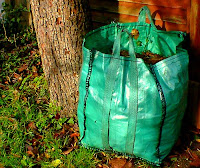Last night I made up a batch of a sweet snack that became popular during my childhood in Australia. As I put it aside to firm up overnight and closed the kitchen curtains, I began planning this post. I was going to say, straight after the title, that this post would not be offering any kind of spell or charm to influence the weather. But then this morning when I opened the curtains to the following scene - well - I began to wonder!

To get back to the cooking. I haven't made this recipe for several years but then this year I have scope for some of the little extras and, rich and varied though the range of shop bought Christmas food has become, this is one that needs to be home-made. Being based on crisped rice cereal, (like the kind that goes snap, crackle and pop) it is a recipe that children seem to be happy to help with. To help make it that bit easier I have measured most of the ingredients by volume rather than weight. A small metric measuring jug makes it all much quicker to get to the fun mixing part.
White Christmas
Ingredient List
100g Trex
150g Creamed coconut (This is the solid kind you buy in a box, not in a can. See on the left below)
1 Teaspoon vanilla
450 ml crisped rice cereal
250 ml dried milk powder
250 ml icing sugar
250 ml dessicated coconut
250 ml chopped dried fruit and nuts - I used dried cranberries, sultanas and almonds
Method
Line a 8 inch square baking tin with baking parchment.
Grate, shred or finely chop the creamed coconut.
In a small pan over a low heat melt the Trex, then add the creamed coconut and stir until that too is melted. (Be careful with this as the coconut will burn quite readily if you don't give it your undivided attention. While a little browning only makes for a toasted flavour, the colour changes and makes the result more of a suntanned Christmas.)
Add the vanilla to the melted liquid and set aside.
Place the cereal into a large bowl and slightly crush it with a spoon.
Stir in the rest of the dry ingredients and mix well.
Now add the liquid mixture and stir well to combine. It will be a rather dry mixture but make sure that all the ingredients are evenly mixed throughout.
Put about half of the mixture into the lined tin and even it out. Pack it down well with the back of a spoon and smooth it over. Pile the rest of the mixture on top and again press it down really firmly especially at the edges and smooth the top.
Now set it aside somewhere cool for several hours to firm up and solidify.
Then turn it out onto a board and use a breadknife to saw it into small squares. It keeps well in a sealed container.
I have seen many variations of this sweet some with glace fruit and crystalised ginger; some with a layer of white icing and silver dragees on top. In Australia the recipe would have Copha a kind of coconut vegetable shortening but as it is not available in the UK I have subsituted Trex and creamed coconut, which is readily available from larger supermarkets and stores which sell ingredients for Indian or Asian cooking. This substitution was recommended by Australia House no less!
Meanwhile in the garden, one of the clipped box bushes had been dressed up as a Christmas pudding.





























 I
I




